Binary Search Trees
So far we have seen two different ways to implement the map abstract data type—binary search on a list, and hash tables. In this section we will consider the binary tree, which is the basis of another common implementation of maps focused on efficient searching.
Before we look at the implementation, let’s review the interface provided by the map ADT. Notice that this interface is very similar to the Python dictionary.
Map()Create a new, empty map.put(key, val)Add a new key-value pair to the map. If the key is already in the map then replace the old value with the new value.get(key)Given a key, return the value stored in the map orNoneotherwise.delDelete the key-value pair from the map using a statement of the formdel map[key].len()Return the number of key-value pairs stored in the map.inReturnTruefor a statement of the formkey in map, if the given key is in the map.
Implementation
A binary search tree relies on the property that keys that are less than
the parent are found in the left subtree, and keys that are greater than
the parent are found in the right subtree. We will call this the BST
property. As we implement the Map interface as described above, the
BST property will guide our implementation. The diagram below
illustrates this property of a binary search tree, showing the keys
without any associated values. Notice that the property holds for each
parent and child. All of the keys in the left subtree are less than the
key in the root; all of the keys in the right subtree are greater than
the root.
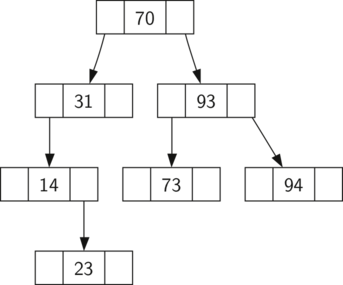
Now that you know what a binary search tree is, we will look at how a binary search tree is constructed. The search tree above represents the nodes that exist after we have inserted the following keys in the order: . Since 70 was the first key inserted into the tree, it is the root. Next, 31 is less than 70, so it becomes the left child of 70. Next, 93 is greater than 70, so it becomes the right child of 70. Now we have two levels of the tree filled, so the next key is going to be the left or right child of either 31 or 93. Since 94 is greater than 70 and 93, it becomes the right child of 93. Similarly 14 is less than 70 and 31, so it becomes the left child of 31. 23 is also less than 31, so it must be in the left subtree of 31. However, it is greater than 14, so it becomes the right child of 14.
To implement the binary search tree, we will use the nodes and
references approach. While it would be possible in Python to implement
the tree using dicts as we have elsewhere in this chapter, doing so
presupposes that we have the very associative structure that we are
implementing!
Our implementation will use two classes: TreeNode to house the lower
level logic to construct and manipulate the tree itself, and
BinarySearchTree to hold a reference to the root node and provide a
map-like interface to the user.
The TreeNode class provides many helper functions that make the work
done in the BinarySearchTree class methods much easier. The
constructor for a TreeNode, along with these helper functions, is
shown below. As you can see, many of these helper functions help to
classify a node according to its own position as a child, (left or
right) and the kind of children the node has. The TreeNode class will
also explicitly keep track of the parent as an attribute of each node.
You will see why this is important when we discuss the implementation
for the del operator.
One of the more interesting methods of TreeNode provides an interface
to simply iterate over all the keys in the tree in order. You already
know how to traverse a binary tree in order, using the inorder
traversal algorithm. However, because we want our iterator to operate
lazily, in this case we use the yield keyword to define our __iter__
method as a Python generator. Pay close attention to the __iter__
implementation as at first glance you might think that the code is
not recursive: in fact, because __iter__ overrides the for x
in operation for iteration, it really is recursive!
Our full implementation of TreeNode is provided below. It includes
three further methods find_successor, find_min and splice_out
which you can ignore for now as we will return to them later when
discussing deletion.
class TreeNode(object):
def __init__(self, key, val, left=None, right=None, parent=None):
self.key = key
self.val = val
self.left = left
self.right = right
self.parent = parent
def is_left_child(self):
return self.parent and self.parent.left == self
def is_right_child(self):
return self.parent and self.parent.right == self
def is_leaf(self):
return not (self.right or self.left)
def has_any_children(self):
return self.right or self.left
def has_both_children(self):
return self.right and self.left
def has_one_child(self):
return self.has_any_children() and not self.has_both_children()
def replace_node_data(self, key, val, left, right):
self.key = key
self.val = val
self.left = left
self.right = right
if self.left:
self.left.parent = self
if self.right:
self.right.parent = self
def __iter__(self):
if self is None:
return
if self.left:
# `in` calls `__iter__` so is recursive
for elem in self.left:
yield elem
yield self.key
if self.right:
# recurse again
for elem in self.right:
yield elem
def find_successor(self):
if self.right:
return self.right.find_min()
if self.parent is None:
return None
if self.is_left_child():
return self.parent
self.parent.right = None
successor = self.parent.find_successor()
self.parent.right = self
return successor
def find_min(self):
current = self
while current.left:
current = current.left
return current
def splice_out(self):
if self.is_leaf():
if self.is_left_child():
self.parent.left = None
else:
self.parent.right = None
else:
promoted_node = self.left or self.right
if self.is_left_child():
self.parent.left = promoted_node
else:
self.parent.right = promoted_node
promoted_node.parent = self.parent
Now that we have our TreeNode class we can begin to write
BinarySearchTree itself. Recall that the core functionality of this
class will be to enable puting to and geting from the tree, so we
begin our implementation with the put functionality.
In order to enable the tree[1] = 'foo' style assignment interface for
our BinarySearchTree instances, we override the __setitem__ magic
method. In this method we first check to see if the tree already has a
root. If there is not a root then we create a new TreeNode and set it
as the root of the tree. If a root node is already in place then put
calls the private, recursive, helper function _put to search the tree
according to the following algorithm:
- Starting at the root of the tree, search the binary tree comparing the new key to the key in the current node. If the new key is less than the current node, search the left subtree. If the new key is greater than the current node, search the right subtree.
- When there is no left (or right) child to search, we have found the position in the tree where the new node should be installed.
- To add a node to the tree, create a new
TreeNodeobject and insert the object at the point discovered in the previous step.
The code below shows the Python code for inserting a new
node in the tree. The _put function is written recursively following
the steps outlined above. Notice that when a new child is inserted into
the tree, the node is passed to the new tree as the parent.
One important problem with our implementation of insert is that duplicate keys are not handled properly. As our tree is implemented a duplicate key will create a new node with the same key value in the right subtree of the node having the original key. The result of this is that the node with the new key will never be found during a search. A better way to handle the insertion of a duplicate key is for the value associated with the new key to replace the old value. We leave fixing this bug as an exercise for you.
class BinarySearchTree(object):
TreeNodeClass = TreeNode
def __init__(self):
self.root = None
self.size = 0
def __len__(self):
return self.size
def __iter__(self):
return self.root.__iter__()
def __setitem__(self, key, val):
if self.root:
self._put(key, val, self.root)
else:
self.root = self.TreeNodeClass(key, val)
self.size = self.size + 1
def _put(self, key, val, node):
if key < node.key:
if node.left:
self._put(key, val, node.left)
else:
node.left = self.TreeNodeClass(key, val, parent=node)
else:
if node.right:
self._put(key, val, node.right)
else:
node.right = self.TreeNodeClass(key, val, parent=node)
The diagram below illustrates the process for inserting a new node into a binary search tree. The lightly shaded nodes indicate the nodes that were visited during the insertion process.
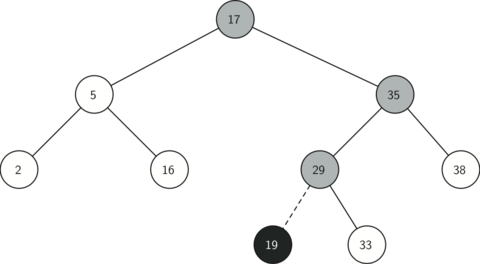
Once the tree is constructed, the next task is to implement the
retrieval of a value for a given key. The get functionality is even easier
than the put functionality because we simply search the tree recursively
until we get to a non-matching leaf node or find a matching key. When
a matching key is found, the value stored in the val of the node is
returned.
Again, inorder to enable a tree[1] retrieval interface, we overload
one of Python’s magic methods—in this case __getitem__. Just like with
__setitem__, the primary purpose of this method is to handle presence
and absence of a root node, and delegates the core get functionality
to _get.
The search code in the _get method uses the same logic
for choosing the left or right child as the _put method. Notice that
the _get method returns a TreeNode to __getitem__, this allows _get to
be used as a flexible helper method for other BinarySearchTree methods
that may need to make use of other data from the TreeNode besides the
val.
def __getitem__(self, key):
if self.root:
result = self._get(key, self.root)
if result:
return result.val
raise KeyError
def _get(self, key, node):
if not node:
return None
if node.key == key:
return node
if key < node.key:
return self._get(key, node.left)
return self._get(key, node.right)
Using _get, we can implement the in operation by writing a
__contains__ method for the BinarySearchTree. The __contains__
method will simply call _get and return True if _get returns a
value, or False if it returns None. The code for __contains__ is
shown below.
def __contains__(self, key):
return bool(self._get(key, self.root))
Finally, we turn our attention to the most challenging method in the
binary search tree: the deletion of a key. The first task is
to find the node to delete by searching the tree. If the tree has more
than one node we search using the _get method to find the TreeNode
that needs to be removed. If the tree only has a single node, that means
we are removing the root of the tree, but we still must check to make
sure the key of the root matches the key that is to be deleted. In
either case if the key is not found the del operator raises an error.
def delete(self, key):
if self.size > 1:
node_to_remove = self._get(key, self.root)
if node_to_remove:
self.remove(node_to_remove)
self.size = self.size - 1
return
elif self.size == 1 and self.root.key == key:
self.root = None
self.size = self.size - 1
return
raise KeyError('Error, key not in tree')
def __delitem__(self, key):
self.delete(key)
Once we’ve found the node containing the key we want to delete, there are three cases that we must consider:
- The node to be deleted has no children
- The node to be deleted has only one child
- The node to be deleted has two children
The first case is straightforward. If the current node has no children all we need to do is delete the node and remove the reference to this node in the parent. The code for this case is shown below.
def remove(self, node):
if node.is_leaf() and node.parent is not None:
if node == node.parent.left:
node.parent.left = None
else:
node.parent.right = None
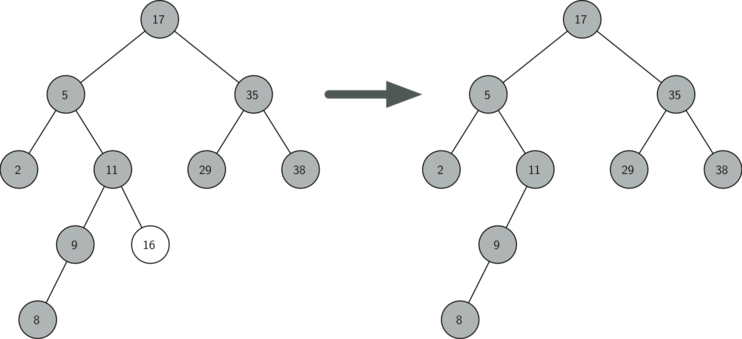
The second case is only slightly more complicated (see below). If a node has only a single child, then we can simply promote the child to take the place of its parent. The code for this case is shown in the next code sample. As you look at this code you will see that there are six cases to consider. Since the cases are symmetric with respect to either having a left or right child we will just discuss the case where the current node has a left child. The decision proceeds as follows:
- If the current node is a left child then we only need to update the parent reference of the left child to point to the parent of the current node, and then update the left child reference of the parent to point to the current node’s left child.
- If the current node is a right child then we only need to update the parent reference of the right child to point to the parent of the current node, and then update the right child reference of the parent to point to the current node’s right child.
- If the current node has no parent, it must be the root. In this case
we will just replace the
key,val,left, andrightdata by calling thereplace_node_datamethod on the root.
Code for this decision process may look like:
elif node.has_one_child():
promoted_node = node.left or node.right
if node.is_left_child():
promoted_node.parent = node.parent
node.parent.left = promoted_node
elif node.is_right_child():
promoted_node.parent = node.parent
node.parent.right = promoted_node
else:
node.replace_node_data(
promoted_node.key,
promoted_node.val,
promoted_node.left,
promoted_node.right
)
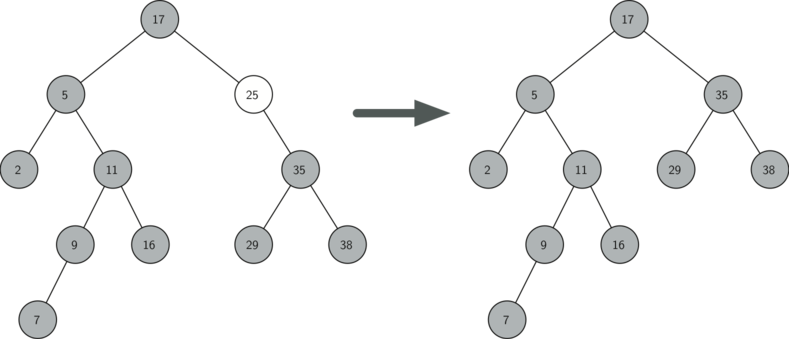
The third case is the most difficult case to handle (see below). If a node has two children, then it is unlikely that we can simply promote one of them to take the node’s place. We can, however, search the tree for a node that can be used to replace the one scheduled for deletion. What we need is a node that will preserve the binary search tree relationships for both of the existing left and right subtrees. The node that will do this is the node that has the next-largest key in the tree. We call this node the successor, and we will look at a way to find the successor shortly. The successor is guaranteed to have no more than one child, so we know how to remove it using the two cases for deletion that we have already implemented. Once the successor has been removed, we simply put it in the tree in place of the node to be deleted.
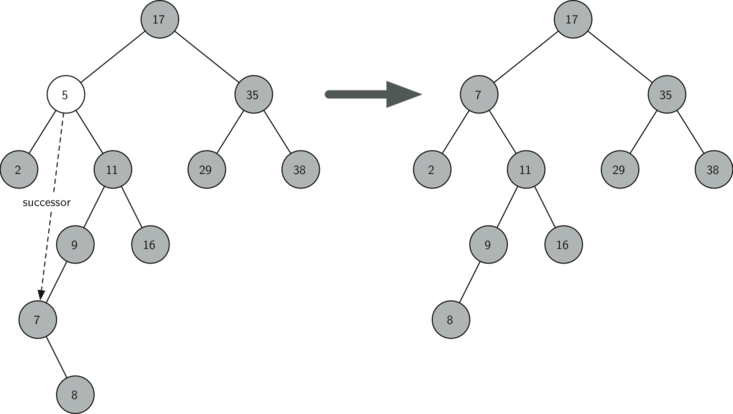
The code to handle the third case is shown below. Notice
that we make use of the helper methods find_successor and find_min to
find the successor. To remove the successor, we make use of the method
splice_out. The reason we use splice_out is that it goes directly to
the node we want to splice out and makes the right changes. We could
call delete recursively, but then we would waste time re-searching for
the key node.
else: # has both children
successor = node.find_successor()
if successor:
successor.splice_out()
node.key = successor.key
node.val = successor.val
The code to find the successor is shown above and as you can see is a
method of the TreeNode class. This code makes use of the same
properties of binary search trees that cause an inorder traversal to
print out the nodes in the tree from smallest to largest. There are
three cases to consider when looking for the successor:
- If the node has a right child, then the successor is the smallest key in the right subtree.
- If the node has no right child and is the left child of its parent, then the parent is the successor.
- If the node is the right child of its parent, and itself has no right child, then the successor to this node is the successor of its parent, excluding this node.
The first condition is the only one that matters for us when deleting a node from a binary search tree.
The find_min method is called to find the minimum key in a subtree. You
should convince yourself that the minimum valued key in any binary
search tree is the leftmost child of the tree. Therefore the find_min
method simply follows the left references in each node of the
subtree until it reaches a node that does not have a left child.
Analysis
With the implementation of a binary search tree now complete, we will do
a quick analysis of the methods we have implemented. Let’s first look at
the put method. The limiting factor on its performance is the height
of the binary tree. Recall that the height
of a tree is the number of edges between the root and the deepest leaf
node. The height is the limiting factor because when we are searching
for the appropriate place to insert a node into the tree, we will need
to do at most one comparison at each level of the tree.
What is the height of a binary tree likely to be? The answer to this question depends on how the keys are added to the tree. If the keys are added in a random order, the height of the tree is going to be around where is the number of nodes in the tree. This is because if the keys are randomly distributed, around half of them will be less than the root and half will be greater than the root. Remember that in a binary tree there is one node at the root, two nodes in the next level, and four at the next. The number of nodes at any particular level is where is the depth of the level. The total number of nodes in a perfectly balanced binary tree is , where represents the height of the tree.
A perfectly balanced tree has the same number of nodes in the left
subtree as it does in the right subtree. In a balanced binary tree, the worst-case
performance of put is , where is the number of nodes
in the tree. Notice that this is the inverse relationship to the
calculation in the previous paragraph. So gives us the
height of the tree, and represents the maximum number of comparisons
that put will need to do as it searches for the proper place to insert
a new node.
Unfortunately it is possible to construct a search tree that has height
simply by inserting the keys in sorted order! An example of such a
tree is shown below. In this
case the performance of the put method is .
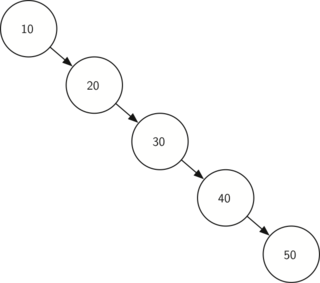
Now that you understand that the performance of the put method is
limited by the height of the tree, you can probably guess that other
methods, get, in, and del, are limited as well. Since get searches
the tree to find the key, in the worst case the tree is searched all the
way to the bottom and no key is found. At first glance del might seem
more complicated, since it may need to search for the successor before
the deletion operation can complete. But remember that the worst-case
scenario to find the successor is also just the height of the tree which
means that you would simply double the work. Since doubling is a
constant factor it does not change worst case